In 1985 Bishop Gerald Mahon, the area bishop for Central London, asked us on behalf of Cardinal Hume, whether we could provide pastoral care for families involved in the so-called ‘sects & cults’. The official name for them was ‘New Religious Movements’. We were asked because of my theological qualification and because both Jackie and I had many years of experience with eastern religions. We said ‘yes, we would’. In the decade that followed we helped literally hundreds upon hundreds of families, from all over Britain.
It is difficult to fully fathom why, at the time, so many youngsters left their traditional church communities to join sects that often were bizarre and extreme. A number of factors can be singled out. The West was beginning to enjoy a boom of material wealth which left many feeling spiritually empty. Traditional Christian communities which often ran on external practice rather than interior depth could not meet the need. Ancient religions from the East seemed to offer greater potential. At the same time the emerging secular and individualist society left sensitive persons feeling vulnerable and lost.
In giving support to people we worked closely with other organizations with a similar purpose: Deo Gloria Outreach, run by the Church of England; FAIR (Family Action Information Rescue), a social organization; and INFORM, an academic information centre, founded by Prof Eileen Barker. Together we produced information leaflets on the various movements. Such info sheets were extremely useful when family members needed to know details about the movement their relatives were involved in. We also ran seminars and workshops for pastoral personnel in various dioceses.
Characteristic features of the NRMs
Without wanting to overgeneralise, here are some of the typical marks of a cult.
Dominant authority plays a central part. Usually there is a cult leader, founder of the group, who totally controls what goes on. Indoctrination tries to stop members from engaging in their own critical thinking. It may amount to even ‘brainwashing’. At times guilt and fear are inculcated to prevent members leaving or changing their mind.
Sects are often imbued with eastern spirituality. Following the religious adherence of the cult leader, this can be Hindu, Buddhist, Sikh or Sufi in origin. Christian sects often originate from Pentecostal Protestant tradition or extreme Catholic splinter groups.
Stress is put on the value of belonging. When people enter the cult they are subjected to ‘love bombing’: to being welcomed, accepted and loved by other members. Strict community living is imposed, leaving little room for privacy. A negative attitude to the hostile world around is taught. The slogan is: “We believe and do what is right, all the others are wrong”. Contact with one’s natural family is forbidden or discouraged.
Often strict discipline is imposed. Members assume a new identity by accepting a new name and by ‘starting a new life’. Total commitment is demanded – including the sacrifice of time, possessions, career and even marriage. Depending on the ethos of the cult, sex may be either totally suppressed or utterly liberal and promiscuous.
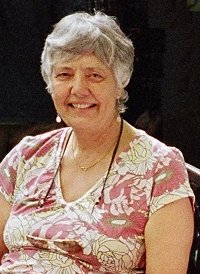
Jackie Clackson
Much of the work of dealing with parents or siblings of persons caught up in the sects and cults fell on the capable shoulders of my Housetop team mate, Jackie Clackson. This applied especially to the many months each year that I spent in India preaching retreats and giving courses. Jackie had the gift of empathy, of sympathetic listening and pastoral sensitivity that was required in this task.
When giving guidance to families on how to deal with relatives who were caught up in such movements, we always stressed a positive approach. One should always start from the recognition that members of sects and cults are seekers who have discovered something good and attractive in the movement. I used to hold up as an example a small cult that worshipped the mother goddess under the Welsh name Rhianne, a cult that aimed at restoring paradise.
The dream can be read in this quotation from the Book of Rhianne in which ‘maids’ stands for human beings in general, ‘men’ for materialists: “When the world was fresh with the dew of the dawn of time, there walked a young race proud upon the earth. A race that saw with eyes more clear than our eyes; with eyes that were not deceived by the shifting shows of earthly things, but saw within to their eternal and changeless Reality. A race whose light was lighter and whose dark was deeper and whose voices sang the music of eternity. And the maids of this race were tall and fair and awesome to look upon . . . It was only in the last senility of that race that the rule of men took hold, and the darkened mind was plunged in the mire of matter.”
We recommended this approach in our leaflet Advice to Relatives and Friends.
In this chapter I will focus on some Catholic sects we had to deal with. From ten on our records I will select four. I will alter the names of sect members or their relatives.
A Sede Vacante splinter group
In July 1986 Marcia came to see us. She had got entangled in a small group centered round Britons Catholic Library in Bloomsbury Square, London. Its leader was Australian-born Martin Gwynne.
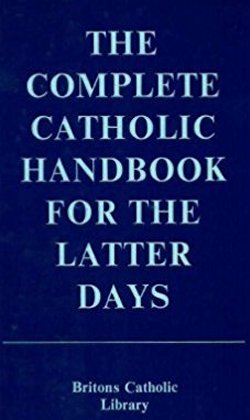
Martin Gwynne’s book
Belief of the group was inspired by extreme traditionalist Sedevacantist thinking. This amounts in short to these tenets: according to Canon 188 § 4 of the 1917 Code of Church Law, clerics lose their positions in the Church by public apostacy. The Pope and all the Bishops in the world apostacised publicly by signing some of the documents of the Second Vatican Council. Therefore since Pius XII’s death in 1958, the See of Rome is vacant. And all Catholic bishops lost their rank. No Catholic Bishop anywhere in the world could validly ordain priest
Martin Gwynne added his own doctrines, as explained in his book “Complete Catholic Handbook for the Latter Days”. No one could be saved unless he or she was part of his small community of followers. Members were subjected to penance, fasting and prayer services day and night.
Apart from Marcia, who came out eventually, we got to know Steve who lived, with his wife Donna, in a retirement home. Gwynne persuaded Steve ‘for the good of his own soul’ to leave Donna and join his community. We do not know what happened next. Later that same year, the Anglican Bishop of London rang us about a woman who had joined the group under suspicious circumstances. I advised him to take a tough stance. He did. Three days later he went to the police who raided the community residence and found that the woman was being kept against her will. She came out . . .
Opus Dei
In April 1988 a certain Mrs Black rang us. She said she was worried about her son, whom she found out by chance, had joined Opus Dei. Now I had a good friend who had become a member of Opus Dei and was aware of their good intentions. Should Opus Dei be treated as a ‘sect’?
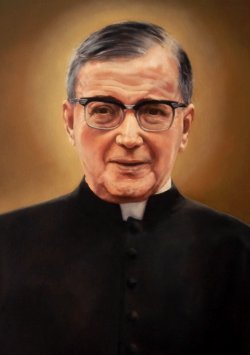
José Maria Escriva de Balaguer y Albas
The founder of the organization was a highly-strung Spanish priest, José Maria Escriva de Balaguer y Albas, who adhered to a rather world-hostile spirituality and practised a somewhat violent mortification. His vision was establishing a ‘new way of sanctification for the faithful in the midst of the world’. Thousands of well-meaning youngsters joined the organization. They were attracted to the high ideals held out and the complete commitment demanded in one’s efforts to attain those ideals.
But, whatever the good intentions of its leaders and recruits, Opus Dei did certainly at the time exhibit some ‘cult’ features. This manifested itself in its recruitment techniques. Future members were carefully targeted. Friends who already were members, would hide this fact so that, at a cleverly orchestrated retreat the earmarked individual could be more easily coached into commitment to the movement. Once inside, group pressure and instilling a sense of guilt could be used to ensure the person stayed in.
A case in point was Charlotte who approached us in September 1989. She had been tempted to join Opus Dei, but pulled back from it. Friends kept putting pressure on her: “you are resisting God’s grace”. “Can I refuse to enter with a clear conscience?”, she kept asking me. I said she could. I gave the same advice to two other ex-members who were troubled by a sense of guilt.
In June 1994 Mrs Wilby told us that her niece in Belgium was in trouble. The niece’s husband was being drawn into Opus Dei. It began to claim most of his time and money. It was disastrous for the family, she said, especially for the children. What could we do to help? After consulting experts we came to the conclusion that Opus Dei was not likely to consciously want to pull married couples apart. A more likely cause was a problem in the relationship. We put Mrs Wilby in touch with people who might be able to help.
In February 1995 Mrs Marshall asked our help to ‘get her 31-year old daughter out of Opus Dei‘. She said she was looking for an ‘exit counsellor’ who could do so. Exit counselling was a rather forceful technique sometimes paid for by parents to ‘liberate’ their children from a sect. We told her that exit counselling was not the right thing to do. It turned out that the daughter had already been a member for 11 years, and that she rarely came to see her mother. We told Mrs Marshall that she should talk frankly with her daughter to find out if everything was alright, but that, in the end, she should respect her daughter’s free will.
Opus Dei has grown out to be a powerful organization in the Church. Its leadership has usually supported the more traditional forces in the Church. My own hope is that the membership, recruited as it undoubtedly is from intelligent and sincere people, will gradually come to recognise its duty to promote genuine reform on all levels of the Church’s life.
The Order of Divine Innocence
In September 1995 Pete Farrow phoned us from his home in Durham. He and his wife had joined a branch of the Family of Divine Innocence. Because of its strange practices he had come out, but his wife was still a member. He was worried about her and his two teenage daughters.
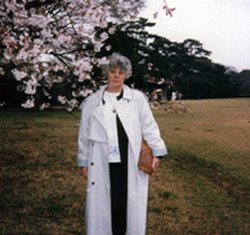
Patricia de Menezes
Pete was right to be worried. The Order of Divine Innocence had been founded by Patricia de Menezes. This woman had become a Catholic in later life and then began to suffer from religious illusions. She imagined to have frequent apparitions from Mary and the Infant Jesus, holding frequent childlike conversations with them. The overall message was: “The first rule is Love, the last rule is Love and all the rules in between are Love.”
But the community she formed was expected to follow a rather strict routine of observances and prayers. Deviation was not tolerated. Hadn’t Jesus assured Patricia: “This spirituality is the Perfect Original Spirituality of the Church Herself. This Order, the perfect Order of My Divine Innocence is the First and last Order! The Alpha and the Omega, I AM. This Order is MY ORDER! This Order is Perfection! The Order of MY Divine Innocence precedes all orders, and supersedes all orders, it is the original perfect Christian Universal Order of God!”
As luck would have it, I met Pete’s bishop, the Rt Rev Ambrose Griffiths, the bishop of Hexham and Newcastle on some other business. I talked to him about Pete’s ordeal, and the bishop said he would be happy to meet Pete in person. This is what happened. It will have helped Pete and, who knows, saved some other families.
The Palmerian Catholic Church
In September 1993 a mental health centre in Cumbria approached us. A woman in their care, they told us, was suffering from a mental breakdown. She claimed to be a member of the the Palmerian Catholic Church. They wanted some background information.
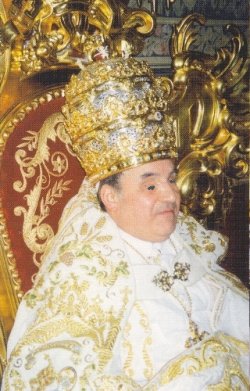
Schismatic Pope Gregory XVI
The Palmerians are a break-away Catholic sect. They took their origin from the Spanish accountant Ferdinand Clemente Dominguez y Gomez who claimed to have been ordained as the Last Pope by Jesus Christ himself. This ordination took place on the night when Pope Paul VI died, the 6th of August 1978. He took the name Gregory XVI. He resided not in apostate Rome, but in the sacred place of el Palmar de Troya. Palmerians rejected the reforms initiated by the Second Vatican Council. Catholic doctrine was enriched with many dogmas proclaimed by Pope Gregory XVII and enshrined in the Palmerian Creed. Members must wear a brown scapular of our Lady at all times. Dress should be decent. At prayer, women must have their heads covered, skirts must be 4 inches below the knee, sleeves must be long, trousers may never be worn. The penitential Palmerian rosary consists of fifty Our Fathers, fifty Hail Marys, fifty Glory Bes and fifty Hail Mary Most Pures.
We do not know if the counsellors were able to relieve the woman in question from her anxieties.
Other Catholic sects we dealt with were Regina Laudis, the New Apostolic Church, the Society of Saint Pius X and the Catholic Counter-Reformation.
Next Chapter: Wisdom from the East?
THE STORY OF MY LIFE
- » FOREWORD
- » Part One. LEARNING TO SURVIVE
- » origins
- » into gaping jaws
- » from the pincers of death
- » my father
- » my mother
- » my rules for survival
- » Part Two. SUBMIT TO CLERICAL DOGMA — OR THINK FOR MYSELF?
- » seeking love
- » learning to think
- » what kind of priest?
- » training for battle
- » clash of minds
- » lessons on the way to India
- » Part Three (1). INDIA - building 'church'
- » St John's Seminary Hyderabad
- » Andhra Pradesh
- » Jyotirmai – spreading light
- » Indian Liturgy
- » Sisters' Formation in Jeevan Jyothi
- » Helping the poor
- » Part Three (2). INDIA – creating media
- » Amruthavani
- » Background to the Gospels
- » Storytelling
- » Bible translation
- » Film on Christ: Karunamayudu
- » The illustrated life of Christ
- » Part Three (3). INDIA - redeeming 'body'
- » spotting the octopus
- » the challenge
- » screwed up sex guru
- » finding God in a partner?
- » my code for sex and love
- » Part Four. MILL HILL SOCIETY
- » My job at Mill Hill
- » The future of missionary societies
- » Recruitment and Formation
- » Returned Missionaries
- » Brothers and Associates
- » Part Five. HOUSETOP LONDON
- » Planning my work
- » Teaching teaching
- » Pakistan
- » Biblical Spirituality
- » Searching God in our modern world
- » ARK2 Christian Television
- » Part Five (2) New Religious Movements
- » Sects & Cults
- » Wisdom from the East?
- » Masters of Deception
- » Part Five (3). VIDEO COURSES
- » Faith formation through video
- » Our Spirituality Courses
- » Walking on Water
- » My Galilee My People
- » Together in My Name
- » I Have No Favourites
- » How to Make Sense of God
- » Part Six (1). RESIGNATION
- » Publicity
- » Preamble
- » Reaction in India
- » Mill Hill responses
- » The Vatican
- » Part 6 (2). JACKIE
- » childhood
- » youth and studies
- » finding God
- » Mission in India
- » Housetop apostolate
- » poetry
- » our marriage
